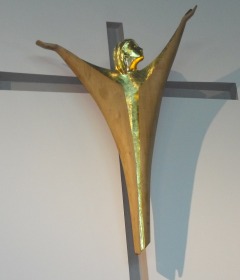
Some years ago a Catholic friend shared with me an exchange he’d had with a Protestant acquaintance. The Protestant had pointed to a crucifix and said, “I don’t know why you Catholics always leave Jesus hanging on the Cross.” To which my friend had replied, “I don’t know why you Protestants are so eager to take him off.”
Both have a point. The Protestant is right that the Crucifixion finds completion in the Resurrection, and the Catholic justly underscores the Incarnation, symbolized by the corpus: Christ suffers as one of us. To me the story is a reminder that no single image covers the richness of our faith.
This is perhaps why I have found one crucifix to be particularly intriguing. The cross pictured here, by the Italian artist Filip Moroder-Doss, adorns the wall above the altar in the Sacramentskerk in Nijmegen. It has been my privilege to pray before it regularly, in the presence of the Blessed Sacrament, since the church first opened in 2011: this is the start of my workday. For that reason I am grateful for the compelling power of this sculpture. It is an example of religious art at its best: it is a continuing revelation, always enhancing one’s awareness of God’s presence.
When visitors first enter this church of the Congregation of the Blessed Sacrament, their response is often one of surprise. That was mine, too. Christ is not hanging from the Cross; he is rising from it. He is golden, glorified. The choice of an image that suggested resurrection came after much deliberation within the community. In a difficult time for the church in Holland—a time of acknowledged failures, self-examination, and diminished participation—I can well imagine the attraction to this hopeful image. See the man: he is young; his face is smooth; his arms are like wings. His ascendance is serene and effortless. He directs our gaze upward. I always think they should have removed the roof to do justice to this crucifix. I feel as if I bump my head whenever I try to follow Christ’s gaze.
But the Resurrection is not the whole story here. This is no dodge, no cheap rescue. See in his shape the stalk of wheat, the grain that must fall and die to bear fruit. Examine the Cross. Those are not beams; that is a cruciform trench (Ypres is just three hours from here). He is leaving the grave. And the corpus is wood and gold—he’s a person of two natures: “We hold this treasure in earthen vessels.” The corpus also folds round to create a hollow space within itself: “He emptied himself, taking the form of a slave....” The crucified body, as represented here, almost puts one in mind of a funnel, as if it were guiding the Spirit down to us. Or it could be a wedge, or maybe even a bottle opener. He’s opening us up. And see his hands; imagine the world there. He’s giving it to his Father.
Just when I thought I had looked at this image in every way it could be looked at, I invited someone into the church, and he said, “He’s dancing!” And I thought, “Well, I’ll be. It’s true. Christ has sprung from the grave and he’s dancing on it.” I almost wanted to applaud.
Please email comments to [email protected] and join the conversation on our Facebook page.
Share
Previous Story
A Bronx Tale
Next Story
The Greatest Generation...